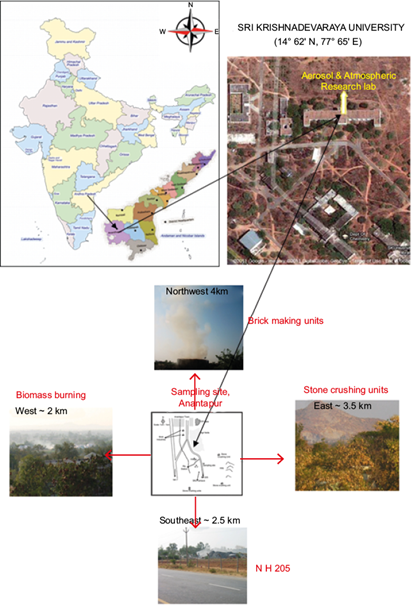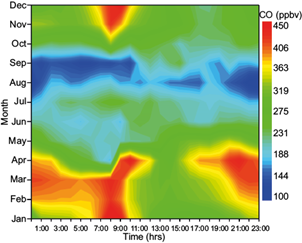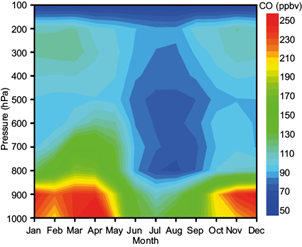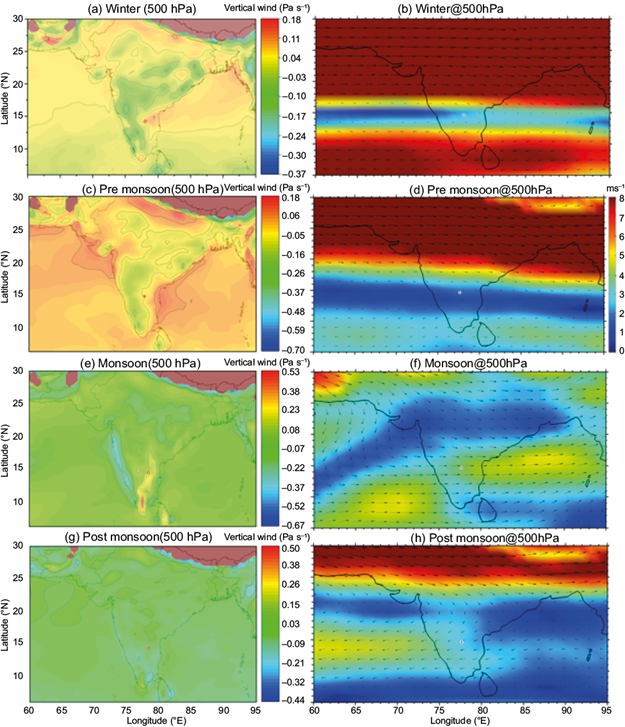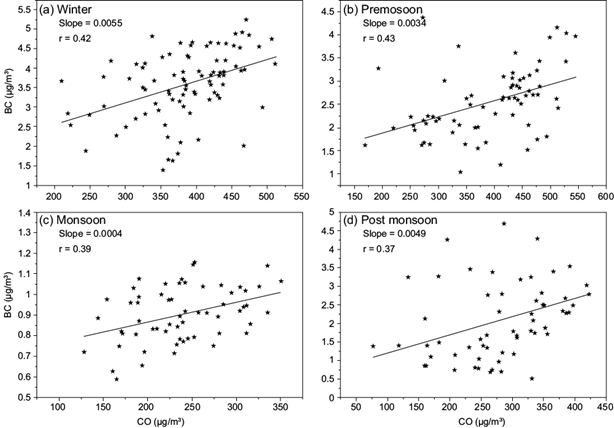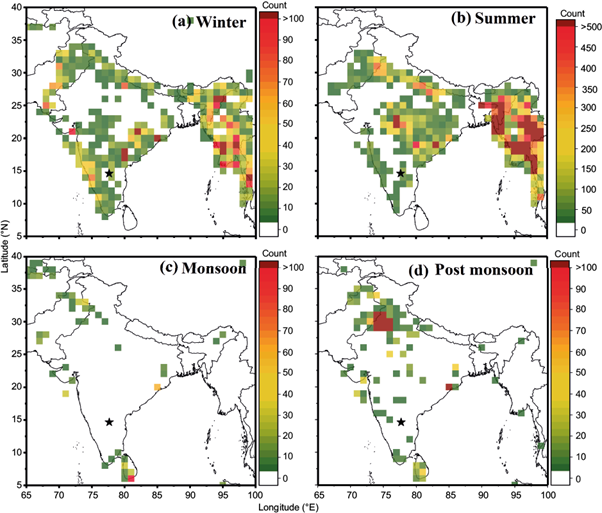1. Introduction
Rapid industrial development and economic growth in South Asia has contributed to increasing emissions of trace gases and particulate matter in the atmosphere, which have a strong impact on both global and regional environment (Akimoto, 2003; Pozzer et al., 2012). The nature and extent of these emissions are employed to develop policies to mitigate their impact. Biomass and fossil fuel burning, as well as vehicular emissions are the most important sources for the formation of carbon monoxide (CO), though a lower amount of CO derives from the ocean and geological activity (Reddy et al., 2008). This gas indirectly contributes to global warming and also reduces the blood’s ability to carry oxygen to body organs. It is known as a precursor of ozone (O3) and is a source of CO2. In addition, CO is responsible for the direct surface emission and oxidation of hydrocarbons (Duncan et al., 2007). It can react chemically with other atmospheric constituents (primarily the hydroxyl radical, OH.) that would otherwise destroy methane. CO’s chemical lifetime is relatively short and spatially variable in concentration, depending on the OH concentrations (Lawrence et al., 2003).
Few studies of CO concentrations have been conducted in India by using in-situ techniques (Lal et al., 2000, 2012; Naja and Lal, 2002; Sahu et al., 2006; Beig et al., 2007; Mallik and Lal, 2014; Sarangi et al., 2014). Apart from real-time measurements, satellite studies have also been performed to study the dynamical effects and long-term trends of CO concentrations in the troposphere (Kar et al., 2004, 2008, 2010; Ghude et al., 2011; Kumar et al., 2013; Worden et al., 2013; Girach and Nair, 2014; Sheel et al., 2014; Yoon and Pozzer, 2014). For better understanding the variations of CO concentrations and their potential sources over a semiarid region, we analyzed CO data both in-situ and from the MOPITT instrument onboard the Terra satellite.
The main objective of the present study is to analyze the diurnal and seasonal variation of CO concentrations during the period 2016-2017. The vertical profiles of CO originating from the MOPITT instrument are examined during the study period. Source apportionment studies are also conducted with the help of the Moderate Resolution Imaging Spectroradiometer (MODIS) fire counts and the Hybrid Single Particle Lagrangian Integrated Trajectory (HYSPLIT) model for the identification of sources’ origins. Finally, a comparison study is carried out for CO in different parts of the Indian region.
2. Site description and instrumentation
2.1 Site description
Anantapur is a very dry continental region which receives low precipitation throughout the year, with the greatest rainfall occurring during the monsoon (Reddy et al., 2016). The sampling site is surrounded by a number of cement plants, slab polishing, lime kilns, and brickworks; however, national highways NH 7 and NH 205 also constitute the largest sources of anthropogenic particles (Gopal et al., 2016). The climate is governed by monsoon-influenced marine weather systems. The entire study period is divided into four seasons: winter (December-February), pre-monsoon (March-May), monsoon (June-August), and post-monsoon (September-November). The real-time near-surface CO concentration levels were measured at the Department of Physics, Sri Krishnadevaraya University (SKU, 14.62º N, 77.65º E, 331 masl), located at the southern edge of Anantapur city (Fig. 1).
2.2 Near-surface CO
Near-surface CO concentrations are continuously monitored using the CO monitor analyzer (APMA-370, Horiba, Germany). The analyzer worked adequately based on the principle of non-dispersive infrared absorption. It uses the AS-type detector from which extremely high-accurate results were obtained without any interference components. The performance, efficiency, accuracy, calibration and advantages of analyzers have been described elsewhere (Reddy et al., 2008). However, when the concentration of the interference gas changes (since there is a time gap for the sample and reference gases to reach the measurement cell) an influence due to the interference gas may occur. In order to address this problem (such as a change in the interference gas concentration) APMA-370 measures the concentration of the interference gas component with an interference compensation detector and corrects its influence on the output signal of the measurement detector. To reduce uncertainty in thr levels, the filter was replaced every 3-4 weeks, and calibration was performed at regular intervals. The CO analyzer was zero calibrated with zero air generator, and span calibration was performed with the help of a multipoint calibrator. The linearity of the instrument was checked with an internal zero gas and five NIST traceable CO standards (60, 250, 300, 500, and 1000 ppb). In addition, daily instrument checks were performed using a 500 ppb CO standard and zero internal gas.
2.3 MOPITT
The vertical distribution of CO mixing ratios was obtained from the Measurements of Pollution in the Troposphere (MOPITT) level 3, version 8 instrument, which is aboard the EOS Terra satellite and has a horizontal spatial resolution of 22 × 22 km and a track swath of 640 km. Daytime data products are archived on a 1º × 1º latitude-longitude grid in different pressure levels (900, 800, 700, 600, 500, 400, 300, 200, and 100 mb). More details about the retrieval algorithm and validation are available in Pan et al. (1995) and Emmons et al. (2010).
2.4 Aethalometer
Real-time measurements of the black carbon (BC) mass concentration were collected using a seven-wavelength Aethalometer (AE 42, Magee Scientific, USA). BC was collected continuously (time resolution of 5 min) from January 2016 to December 2017. The aethalometer measures optical attenuation due to particles deposited on a quartz filter (filter-based technique) at seven wavelengths: 370, 470, 520, 590, 660, 880, and 950 nm, with flow rate maintained at 3 LPM. The BC measured at 880 nm is considered as the standard, since BC is the principal light absorber at that wavelength. More details about the uncertainty in the estimation of BC mass concentration with an Aethalometer and correction factors were well documented by Hansen et al. (1984) and Weingartner et al. (2003).
2.5 Concentration weighted trajectory (CWT) analysis and MODIS fire counts
Concentration Weighted Trajectory (CWT) analysis was performed to identify the relative contribution of potential source regions to CO levels (Nazeer et al., 2018; Kalluri et al., 2019, 2020a). Many researchers have also used HYSPLIT to identify the pollution transport process in different regions. In the CWT technique, trajectories reaching over the study site are weighted based on the mean concentration measured at the location during the arrival of the trajectory. In this technique, each grid cell is assigned a concentration obtained by averaging associated concentrations that crossed the grid cell:
where Cij is the average weighted concentration in the ij th cell, l is the index of the trajectory, M is the total number of trajectories, Cl is the concentration observed in the trajectory endpoint, and τijl is the time spent in the ij th cell by the trajectory l (Seibert et al., 1994). The fire-count data was obtained from the Fire Information for Resource Management System (FIRMS, http://firms.modaps.eosdis.nasa.gov/firemap/). MODIS provides fire information based on a brightness temperature algorithm at the 4- and 11-mm channels. Confidence levels ranging from 0 to 100%, were used to assign one of three fire classes to all the fire pixels. Further details about the principle and retrieval algorithm are available in Giglio et al. (2003). In the present study, data with high confidence (> 80%) was considered.
3. Results and discussion
3.1 Diurnal and monthly variation of CO
The observed diurnal variation of CO is characterized by two peaks during the morning (07:00-09:00 LT) and night hours (21:00-23:00 LT). Low concentrations are noticed during daytime (12:00-15:00 LT) (Fig. 2). The diurnal variation of CO shows a predominant peak during the morning as compared to the evening, which may be due to variations in the mixed layer height and anthropogenic sources. In contrast, during the evening, traffic emissions remain almost the same, but the mixed layer height decreases, which results in higher CO concentrations. During the night, CO levels showed little variation in comparison to daytime. The diurnal variation with low concentration during the afternoon could partly be affected by lower anthropogenic activities, photooxidation processes, and a high mixed layer height. A similar diurnal variation of CO was found in other regions of India, such as Ahmadabad (Lal et al., 2000), Chile (Rappengluck et al., 2005), Pune (Beig et al., 2007), Kanpur (Gaur et al., 2014), Agra (Verma et al., 2017), and Kathmandu valley (Bhardwaj et al., 2018).
The in-situ measured CO surface levels have no obvious seasonal variability. Monthly mean maximum and minimum of CO were noted in March (324 ± 59 ppbv) and August (155 ± 28 ppbv). The monthly maximum CO concentration was observed in March, on account of anthropogenic emissions from agricultural fields (north) close to the measurement site. Crop residues are burned by farmers to clear agricultural fields to enhance the next crops yield, which contributes to a higher amount of CO (Dalvi et al., 2006). The seasonal variation of CO showed its highest levels in winter (329 ± 52 ppbv) followed by pre-monsoon (327 ± 57 ppbv), post-monsoon (234 ± 36 ppbv) and monsoon (192 ± 22 ppbv). The highest levels of CO during winter may be attributed to: (1) weak photochemical removal, (2) an increase in local emission sources, and (3) low wind speeds that cause entrapment of pollutants near the surface. The lowest concentration was observed during the monsoon season due to winds blowing from the Arabian Sea.
3.2 Vertical variability of CO retrieved from MOPITT and synoptic meteorology
Figure 3 shows the vertical distribution of CO mixing ratios in different months retrieved from the MOPITT instrument over Anantapur. In general, the CO mixing ratio decreases with height from 1000 to 100 hPa; however, the surface CO mixing ratio was stronger at lower altitudes in all months. CO exhibits distinct seasonal variations near the surface (1000 hpa) with highest levels during the pre-monsoon (244 ± 37 ppbv) and lowest in the monsoon (134 ± 10 ppbv). The pattern of seasonal variation at low altitudes (1000 hPa) observed by MOPITT was consistent with ground-level measurements. However, at low pressure levels (low pressure corresponds to a higher altitude), CO mixing ratios were found to be low during the monsoon due to washout processes, air masses originating from the Arabian Sea and less human activity. During the pre-monsoon, numerous fires spotted in central India were identified by MODIS. The continental air masses dominated during winter and pre-monsoon, resulting in higher CO concentrations at high altitudes (200 hpa). Vertical wind distribution an important cause of the vertical mixing of CO in the upper troposphere. Figures 4 and 5 represent the seasonal vertical wind and horizontal wind circulation at 850 and 500 hPa over the observational site, obtained from the European Centre for Medium-Range Weather Forecasts (ECMWF)-interim reanalysis and Modern-Era Retrospective Analysis For Research And Applications (MERRA) data during 2016-2017. The color bar in the figures represents wind speed, and the arrow indicates the wind direction and the white square indicates the observation site. The wind during winter, pre-monsoon and post-monsoon at 850 hpa was originated from the northwest and passed through central India before reaching the observation site. The northwestern winds are responsible for the transport of CO from urban locations in central India. During the post-monsoon, a synoptic wind pattern originated from the central Indo-Gangetic Basin (IGB), which is due to an additional source of CO mixing ratios observed at low pressure levels over the measurement location. During the monsoon, season winds generally originate from the Arabian Sea and low anthropogenic activities, which are responsible for low CO mixing ratios over the measurement location. Figures 4 and 5 show that the observed CO concentration at high altitudes during winter and the post-monsoon is attributed to the vertical transport of surface level CO in the mid and upper troposphere. This is due to the fact that vertical velocities are negative and much weaker (downward motion) during winter and the post-monsoon seasons over the observational site, as seen in Figure 4a, g.
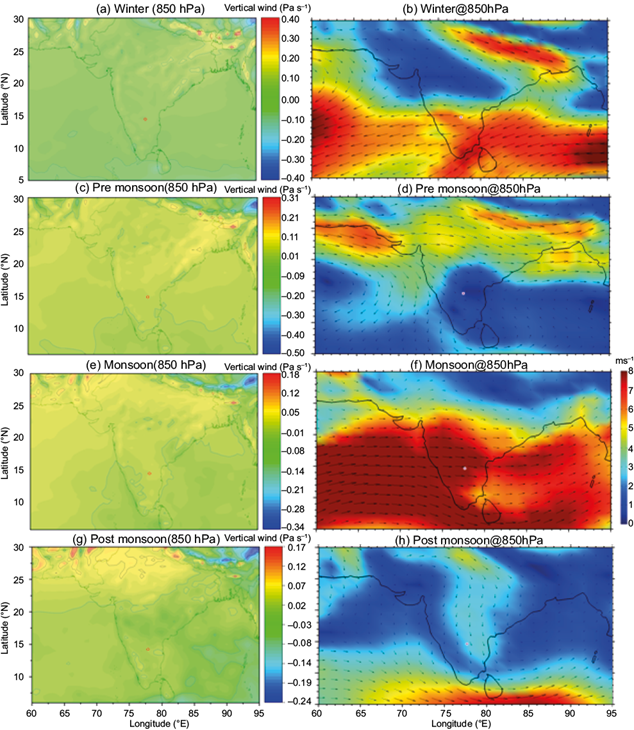
Fig. 4 Seasonal variation of vertical and horizontal winds at 850 hPA. The left panel indicates vertical velocities (Pa s-1), while the right panel indicates horizontal winds (m s-1) and the circle shows the measurement location.
3.3 Relation between BC and CO
BC and CO are a result of the combustion of fossil fuel and biomass burning, and they have a relatively long atmospheric lifetime. Both are inert chemically in a timeframe of a few hours, thus, chemical reactions are not expected to change their concentrations during air mass transport between emission sources and measurement sites (Baumgardner et al., 2002). The scatter plots of BC and CO for different seasons are shown in Figure 6a-d. The correlation coefficient between CO and BC was found to be 0.42,0.43,0.39,0.37 for winter, pre-monsoon, monsoon and post-monsoon, respectively. The moderate correlation between CO and BC was influenced both by emissions from local activities and transport over the observation site. As suggested by previous studies (Kalluri et al., 2017, 2020b; Gopal et al., 2014, 2017) long-range transport could be an important source of absorbing aerosols (except during the monsoon) over the measurement location.
3.4. Source apportionment and MODIS fire counts
In order to identify the CO transport pathways, isentropic CWT cluster analysis was derived based on air mass back-trajectories data at an altitude of 500 m above the ground level using the HYSPLIT model and the MODIS Fire Mapper products to give an idea about the location and extent of fires for the entire period (Figs. 7 and 8) (Draxler et al., 1997). Local sources contribute actively to the measured CO, whereas polluted air originated from upwind high industrialized regions also play a part in the enhancement of CO as is evident from the observed trajectories during winter (Fig. 8a).
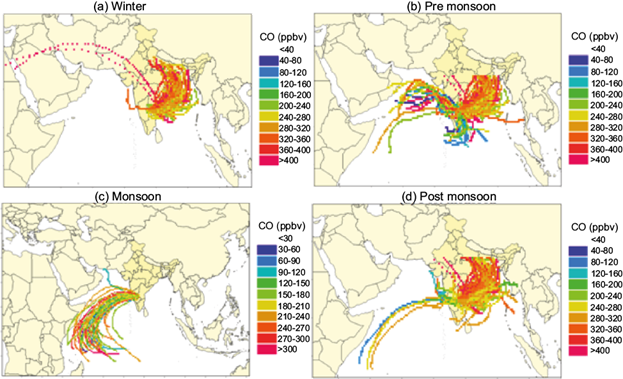
Fig. 8 Five-day isentropic HYSPLIT back-trajectories reaching over the study location in different seasons during the study period.
Furthermore, a widespread of active fires was observed by MODIS in areas of the northeastern regions compared to other regions during the pre-monsoon, indicating the significant influence of biomass burning in the production of CO and its concentration levels in the troposphere (Figs. 7b and 8b). A similar condition occurs during the post-monsoon, although less fires befall over the IGB region, and most of the anthropogenic particles are removed by the washout process triggered by the southwest monsoon over the measurement location (Kalluri et al., 2016, 2017). During the monsoon, winds originate from the Arabian Sea and pollution from anthropogenic activities is removed by the washout process (Fig. 8c).
3.5. Comparison with other sites in India
It is interesting to compare our results with those obtained in other Indian regions (Table I). It can be seen that CO concentrations over the study region were greater than in a high altitude location (Nainital) and a rural location (Gadanki). However, it can also be noticed that CO concentration levels over polluted urban locations (Dehli, Agra, Kanpur) are more than twice compared with the present study location. Furthermore, the seasonal variation of CO levels at the study site and Udaipur was almost similar except for the post-monsoon. A large difference was observed in both regions during the post-monsoon due to s change in the direction of air masses. However, CO levels at the measuring site were higher than in Udaipur since in the latter farmers burned crop residues from agriculture activities.
Table I Comparison of CO concentration levels over Anantapur with those reported from a other locations in India.
| Station | Period | Concentration (ppbv) | Reference |
| New Delhi | 2000-2009 | 2940 ± 1729 | Chelani, 2012 |
| Delhi | Jan 2013-Dec 2014 | 2500 ± 400 (PoM), 2500 ± 300(W), 2400 ± 800 (M) | Tyagi et al., 2016 |
| Agra | Nov 2003-Feb 2005 | 710 ± 159.4 | Renuka et al., 2008 |
| Kanpur | Jun 2009-May 2013 | 721 ± 403 | Gaur, 2014 |
| Ahmedabad | 2002 | 385 ± 200 | Sahu et al., 2006 |
| Gadanki | 1993-1996 | 237 ± 64 | Naja and Lal, 2002 |
| Nainital | 2009-2011 | 174 ± 108 | Sarangi et al., 2014 |
| Udaipur | 2010-2011 | 462 ± 85 (W), 297 ±64 (PM), 252 ± 52 (M), 37 ± 58 (PoM) | Yadav et al., 2014 |
| Anantapur | Jan 2016-Dec 2017 | 329 ± 52 (W), 327 ± 57 (PM), 234 ±36 (M), 192 ± 22 (PoM) | Present study |
| Kathmandu Valley | Dec 2012-June 2013 | 500 ± 230 | Mahata et al., 2017 |
| Agra | Mar 2015 - Feb 2016 | 770 ± 466 ppb (W), 466 ± 301 (PoM) 232 ± 223 (PM), 153 ± 122 (M) | Verma et al., 2017 |
W: winter; PM: pre-monsoon; M: monsoon; PoM: post-monsoon.
4. Conclusions
In this study we presented a comprehensive analysis of CO concentrations using in-situ and MOPITT satellite observations from January 2016 to December 2017 over a semi-arid region in India (Anantapur). The important findings of the present study are summarized as follows:
The seasonal mean variation of in-situ measured CO concentrations was highest (329 ± 52 ppbv) during the winter and lowest (192 ± 22 ppbv) during the monsoon.
Continental air masses dominated during winter and pre-monsoon, resulting in secondary peaks of CO concentrations at high altitudes (200 hpa).
The moderate correlation between CO and BC is noticed at the observation site, where measurements were influenced by emissions from various sources.
The CWT analysis obtained from HYSPLIT suggests that except for the monsoon, air masses transported from central parts of India and the IGB region play a vital role in enhancing concentration levels at the receptor site.











 nueva página del texto (beta)
nueva página del texto (beta)

